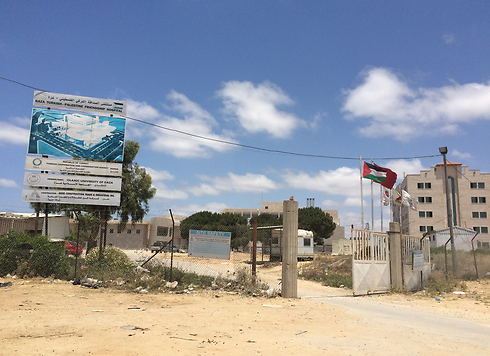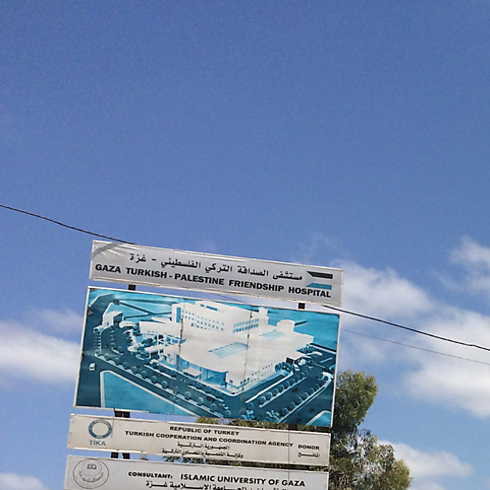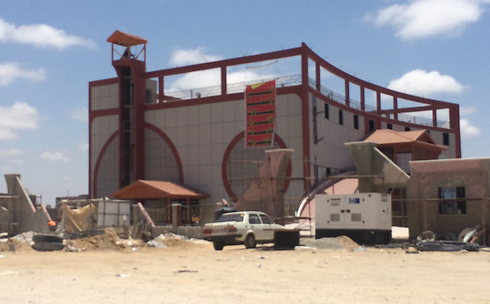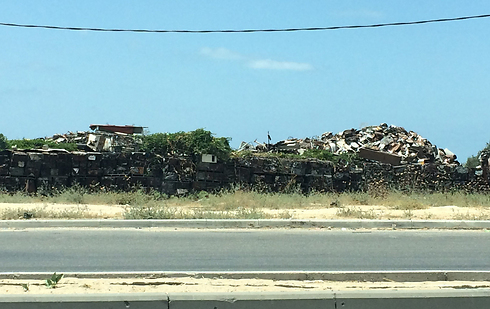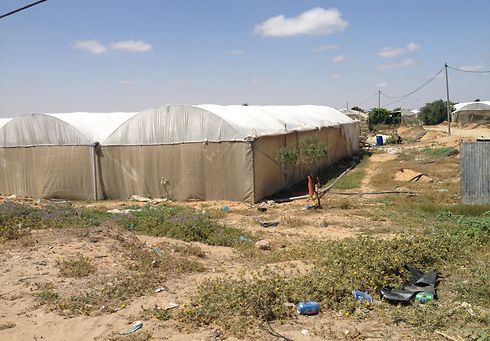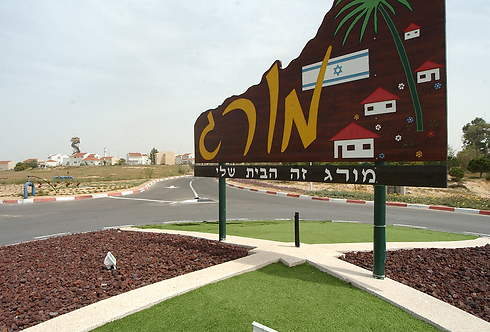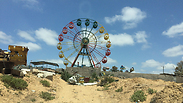
A decade after Israel left, Gaza remains familiar yet different
On the ruins of Netzarim, the Palestinians built a theme park with a giant ferris wheel, while public buildings in Neve Dekalim are now a branch of al-Aqsa University. Where Ganei Tal once stood, the children of Khan Younis are now enjoying water slides. Maurizio Molinari, a correspondent for Italian newspaper La Stampa, went back to the settlements Israel evacuated in the summer of 2005.
Standing on a small hilltop by the side of the road is a green sign in Arabic: "The Palestinian Authority, the Liberated Lands Administration, the liberated land of Taibe." For the residents of the Gaza Strip, this is Taibe, the good land. For the Israelis who once lived here, it will forever be Netzarim.
It's been 10 years since the disengagement from the Gaza Strip, and all traces of the Netzarim settlement have disappeared. It has simply been wiped off the face of the earth. The Palestinians have destroyed everything that the Israel Defense Forces left intact after the evacuation. The synagogue was burned to the ground, and Islamic Jihad flags now fly where the house of worship once stood. They even uprooted the old palm tree that once stood in the courtyard of the seminary.
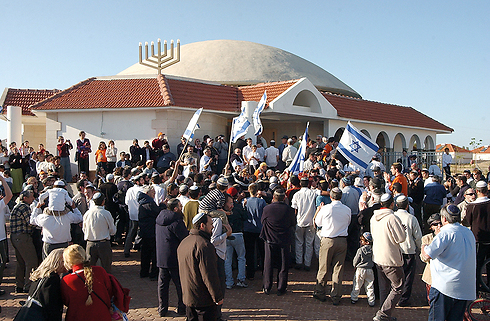
On the ruins of the settlement, where 60 Israeli families lived prior to the disengagement, the Palestinians have built an amusement park, complete with a Ferris wheel, small rollercoaster, carousel and various other rides in a myriad of colors – a lone island in a sea of sand dunes and fields, and all surrounded by a gray concrete wall and piles of rubbish and scrap.
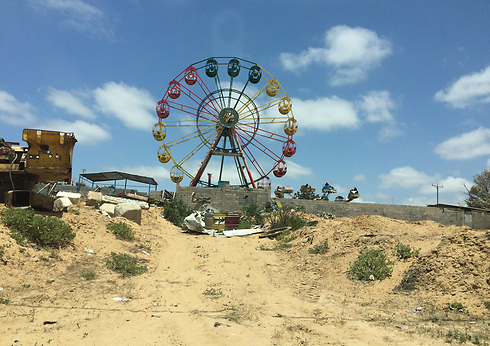
From time to time, buses from Gaza arrive to drop off schoolchildren for a day of fun. Ahmed, the manager of the amusement park, is there to welcome them. "It gives me great joy to see these children playing among the Jihad flags, where the occupiers once sat," he says.
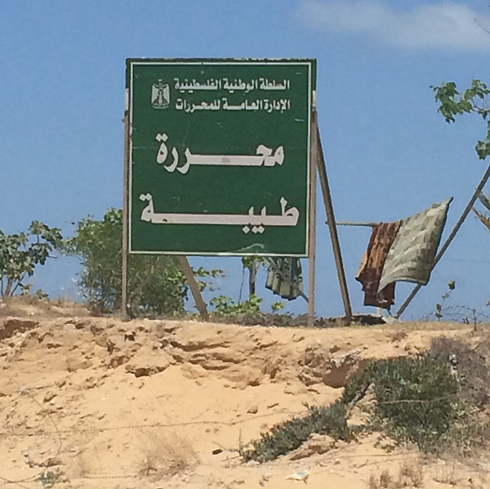
Near the entrance to Netzarim, where there was once a handsome square with a stretch of lawn and a few picnic tables, a university hospital is in its final stages of construction. The project, like many others in the Strip following the disengagement, has been funded by the Turkish government. Turkish and Palestinian flags fly alongside one another at the entrance to the construction site; and a large sign, which displays a simulation of the structure in its final form and the names of the developers and contractors, notes that the project is part of the cooperation between the two nations. The only thing missing is a picture of Recep Erdogan.
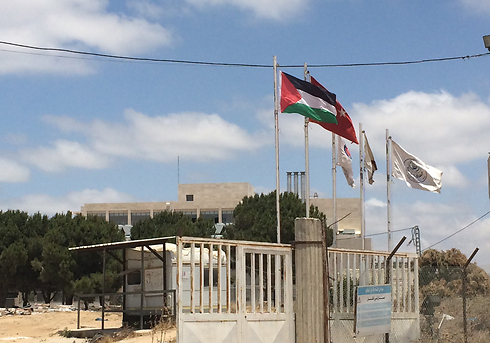
Netzarim no longer exists. But still today, a decade since the disengagement, it remains a symbol. For the Palestinians, it's a symbol of the occupation – an Israeli enclave in the heart of the Gaza Strip, 500 Israelis among one million Palestinians. But for the Israelis who once called it home, and for the many others who fought the disengagement plan, Netzarim is a symbol of the expulsion, the displacement, the destruction. It's hard to remain indifferent to the image of Netzarim residents leaving their homes in a quiet funeral-like procession, carrying the seven-branched menorah that once graced the roof of the synagogue and is now on display at the Gush Katif Museum in Jerusalem.
In order to find physical and tangible traces of an Israeli presence in the Netzarim area, you have to travel about a kilometer and a half down the road that leads to the Karni Crossing, until you get to Salah al-Din Road, the main thoroughfare that crosses the Strip from north to south. This is the Netzarim Junction, one of the most accursed locations in the Gaza Strip during the Second Intifada.
The IDF outpost that once ruled over the junction has been turned into a dump for old cars and trucks, but the concrete barriers that protected the outpost are still there – a dividing line between the road and the pile of rusted vehicles. On the other side of the junction stands a Hamas observation and security post, where members of the organization that took control of the Strip some two years after the disengagement stop and inspect vehicles making their way to and from Gaza City.
Hollywood – Gaza style
We continue south along the Strip's main highway, the Tancher Route – the Nusseirat refugee camp on our right, the El-Bureij camp on our left; and after passing through Deir al-Balah, a city of some 60,000 inhabitants, we reach the intersection at the entrance to Gush Katif.
Before the Oslo agreement in 1994, Israelis were able to travel freely along this section of road. After the agreement, which gave the Palestinian Authority control over the cities and refugee camps and left Israel with about 40 percent of the Strip, the road was closed to Israeli traffic. A Netzarim resident who wanted to get to the Mizrahi Bank branch in Neve Dekalim or visit family in Kfar Darom, some 12 kilometers away, was forced to return to Israel through the Karni Crossing, nearby Kibbutz Nahal Oz, travel south along the border, and re-enter the Strip through the Kissufim Crossing.
Around 8,000 Israelis were living in the Gaza Strip on the eve of the pullout – the majority in Gush Katif in the south of the Strip, and the remainder in Netzarim, Kfar Darom and the three settlements in the north of the Strip (Nisanit, Dugit and Elei Sinai). The concrete blocks and protective barriers that the IDF positioned along the road at the entrance to Gush Katif are still there, silent testimony to the lengthy Israeli presence in the area; and you can still see the ruins of an abandoned IDF outpost, which has also become a garbage disposal site.
On our way south, we encounter Hamas operatives on motorcycles. Police officers in blue uniforms keep an eye on the intersections. Scattered among the remains of the Israeli settlements along the length of the road through Gush Katif are training camps and bases belonging to the various armed groups in the Strip – not only Hamas, but Islamic Jihad, the Popular Resistance Committees and the Popular Front for the Liberation of Palestine too. Each organization proudly flies its flag at the entrance to the various training facilities to show who's in charge there. The sound of explosions and gunfire fills the air from time to time. Plumes of smoke and dust clouds rise up from the ground. Everyone here is readying for the next conflict.
The last thing you would expect to find here – smack bang in the middle of the training areas, instruction bases and Hamas strongholds – is a giant amusement park.
Built on the ruins of Ganei Tal, in the center of the Gush Katif settlement bloc, is Asda City, a complex that covers almost the entire area of the former settlement and includes three main attractions – an amusement park, a huge swimming pool with water slides, and a small zoo. The entrance fee is just NIS 3 per person; but in the Gaza Strip, where the unemployment rate of 43 percent is among the highest in the world, even that could be considered a luxury.
According to the park's manager, Said al-Badir, 32, the original plan was to establish a movie city – a Gaza-style Hollywood of sorts. "After the Israeli withdrawal, we tried to turn the place into a large location for producing and filming movies," al-Badir tells us. "But in fact we only managed to film and produce one movie, Ahmed Akal, which is named after a prominent resistance activist against the Jews who we view as a great hero; and then we changed the plans and decided to focus on the children."
Asda City's amusement park is the second I have encountered since the beginning of my tour. It has a Ferris wheel, a pirate ship and a Dora the Explorer-themed carousel, where young girls with scarves covering their heads wait in line for their chance on the ride. And there's also a small train – its engine a modified tractor painted in shades of yellow and green, and its carriages boasting drawings of Mickey Mouse – that travels along the park's pathways with a bearded man at the wheel.
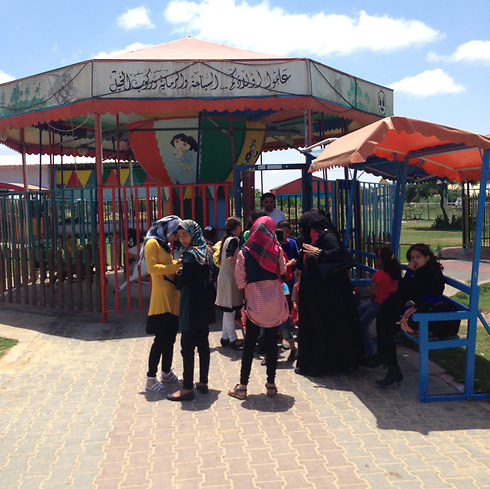
The star of the zoo is a young lion that arrived when still a cub. "We brought him here from Egypt some two years ago through the tunnels," al-Badir says. "He was so small that we were able to fit him in a box. But today he is truly the king of the beasts. The only problem is that he suffers a little in the hot climate."
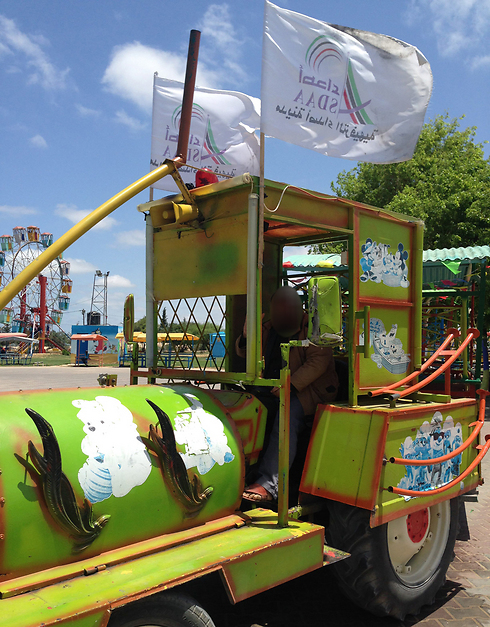
Incidentally, he's not the first lion in the Strip: During Operation Cast Lead (2008-2009), a lion escaped from the zoo in Gaza City and its fate still remains a mystery.

There are no elephants, rhinos or giraffes at the Asda City zoo. After all, it's tough to smuggle an elephant through a tunnel, even when it is still a calf. The children of Khan Younis, therefore, have to make do with baboons, ostriches and deer.

Asda City is the Palestinian version of the zoo that existed in Gush Katif before the disengagement. Katifari – a combination of Katif and safari – sat at the entrance to Neve Dekalim, opposite the gas station. When Gush Katif was evacuated, so too were the zoo's residents, with Shaul the camel leading the way.
Flowers and Palestinian flags
Neve Dekalim, the unofficial capital of Gush Katif, was the largest settlement in the bloc – 500 families, about 2,600 residents and home to the offices of the Hof Aza Regional Council, along with the bloc's shopping center, industrial area and police station. The settlement also boasted two yeshivas, two large synagogues, a school and religious seminaries for girls, and a community center.

Adjacent to Neve Dekalim was the Gush Katif cemetery – 48 graves, including six of Gush Katif residents murdered in terror attacks and three of IDF soldiers. Under the disengagement plan, all the graves were emptied and the remains were reburied in cemeteries in Israel.
Following the evacuation of the Strip, the IDF razed all the residential structures in the settlements; but in keeping with a government decision at the time, all public buildings and synagogues were left standing. The Palestinians demolished one of the Neve Dekalim yeshivas and the two synagogues a few days after the Israeli pullout; but the remaining public buildings are still intact, and the square in the middle of the commercial center has hardly changed. Only now, instead of seeing boys wearing skullcaps and girls in long skirts, you run into Palestinian students in hijabs, and Palestinian flags fly above the well-kept lawns and flowerbeds.
The Palestinians chose to take full advantage of what the Israelis left behind at Neve Dekalim, and the center of the former settlement has been converted into a university – a branch of the al-Aqsa University, which has a student body of around 28,000.

The Hof Aza Regional Council building serves currently as the campus administration headquarters, following refurbishment and a paint job in shades of brown; and the offices of former council head Avner Shimoni and security officer Ami Shaked are occupied today by the university's senior officials. A large picture of Jerusalem's Old City hangs in the lobby of the building.

"We tell every student who starts studying here that this is where the occupiers lived and resided," says Prof. Nimat Shaban Alwan, vice-president of the university. "We are moderates, not extremists," he emphasizes, "and we want to live in peace with our former enemies."
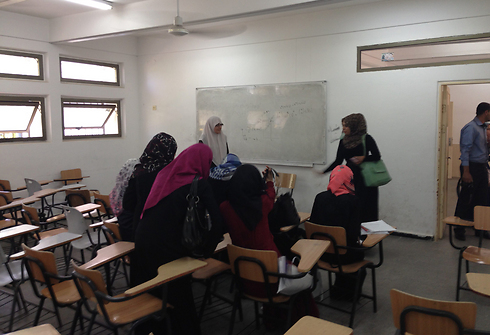
But then I notice the map hanging on the wall of his office – a map of Greater Palestine, from the Jordan River to the Mediterranean Sea, without any sign of the State of Israel.
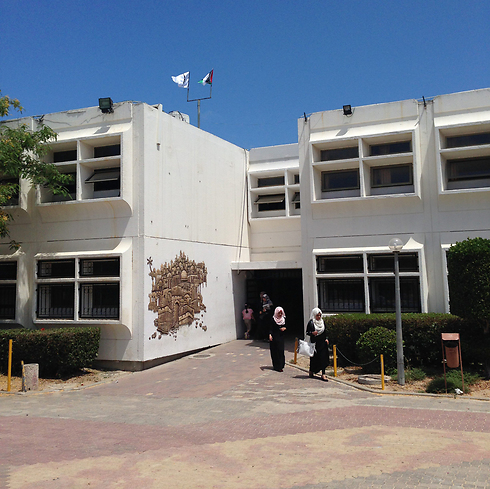
The prefabricated building that used to serve as the Neve Dekalim regional school, where generations of Gush Katif children once studied, is now an Islamic college for girls; and on the other side of the access road to the settlement, the buildings that used to house the religious seminary for girls are now home to the Gaza Polytechnic Institute. Only the Neve Dekalim basketball court (the former community center) still serves its same original purpose.
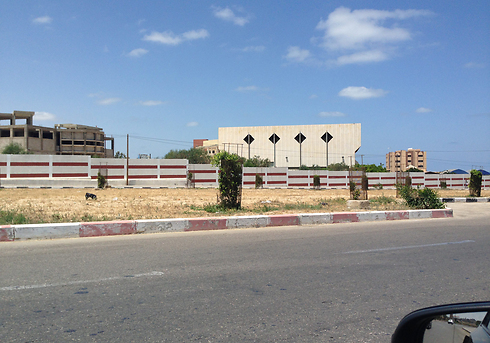
Almost nothing remains of the Gush Katif synagogues. The synagogue in Atzmona served for several years as a training facility for Hamas terrorists, while the remaining synagogues and yeshivas (aside from the one in Neve Dekalim that is now a part of al-Aqsa University) were systematically destroyed by the Palestinians. Some were torched and others were bulldozed to the ground, with the acts of destruction usually accompanied by victory celebrations that were documented and captured on film. No one tried to hide a thing – on the contrary.
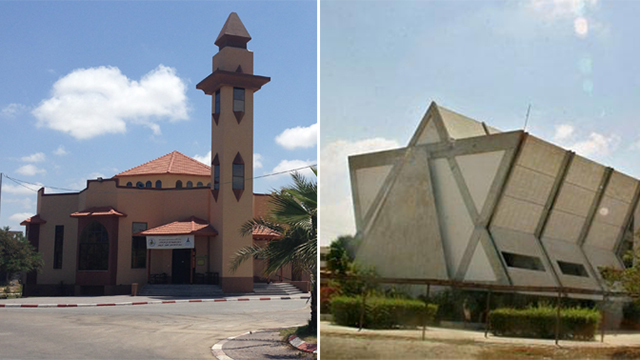
When Muammar Gaddafi expelled the Italians from Libya in 1970, he chose not to destroy the main church in Tripoli, and instead turned it into an Islamic school for girls. The Hagia Sophia Church in Istanbul became a mosque. But none of the synagogues that stood in the Gaza Strip after the disengagement was converted into a Muslim house of prayer. The Palestinians preferred to destroy them completely. "We wanted to erase all traces of the Israeli presence in Gaza," a resident of Deir al-Balah told me.
But traces of the Israeli presence remain clearly evident on the ground, and not only in Neve Dekalim. The Netzer Hazani settlement, for example, has become a furrowed field, with a crisscross network of paths; but when comparing satellite images from before the disengagement with ones from today, it's plain to see that the original network of streets and squares remains unchanged. Only the houses are gone.
In updated aerial photographs, Morag, the isolated settlement situated between Rafah and Khan Younis, looks like a mishmash of greenhouses and agricultural fields, with no other trace of the once-flourishing community at the south-east end of Gush Kaitf to be seen. But the area still shows some signs of a former Israeli presence – the guard post and concrete barriers of the IDF outpost that defended Morag; a small structure with solar panels on its roof that now serves as a military position; and the greenhouses too, some of which were inherited from Israel.
Most of Gush Katif families earned their living from agriculture – organic crops, leaf vegetables, tomatoes and flowers. The settlements – and Netzer Hazani, Ganei Tal and Morag in particular – were surrounded by huge tracts of land packed with greenhouses; and following the evacuation of the Strip, they were handed over to the Palestinians intact. Some remain abandoned; but most are still being used today by the local farmers.
A cup of coffee in Paradise
At Paradise Cafe on the shores of Gush Katif, we strike up a conversation with Mohammed, the waiter, a resident of Deir al-Balah. He was 14 when he first laid eyes on the beautiful coastline, known today as Deir al-Balah Beach. It was soon after the disengagement.
"I remember it like it was yesterday," Mohammed says. "The checkpoints along the road disappeared all of a sudden and we could get here. Before then, only Israelis were allowed to come here. We had never seen anything like it before – such a long stretch of beach, so big. For us, it was like stepping into paradise, and hence the name."
Palm Beach, a few minutes' drive from Ganei Tal, has become Gaza's Riviera. Okay, it's not the French Riviera, or the Italian, but it does offer a host of cafés and restaurants that are open almost around the clock, along with well-kept lawns and straw-roofed sun shelters and colorful beach tents; and when you sit facing the sea, and sip on a cup of tea or cold soft drink (but not alcohol, which is forbidden under Islamic law), and listen to the rustle of the wind and the sound of the waves, you can forget for a moment that you're in the Gaza Strip, where less than a year ago a war was raging.
"It's hard for us to rebuild Gaza because every once in a while there's a new war that sets back the clock," complains Sha'aban, a student at al-Aqsa University. But a year after Operation Protective Edge, and 10 years after the disengagement, there's a feeling in the Strip that something may be about to change.
Rumors in the Strip of late tell of secret negotiations that are underway between Hamas and Israel. Whether they be true or not, it's the No. 1 topic of conversation in the Gaza market these days.
Hamas officials have posted signs in Arabic and English along the jetty at the Gaza Port – Exit and Entry. The Palestinians' demand for a commercial sea route from Gaza to Cyprus – which would mean an end to the marine blockade and a long-term ceasefire agreement – remains a distant objective. The recent rocket attacks on Israel – carried out this time by Salafist groups affiliated with Islamic State – don't bode well either. But you get a sense of optimism of sorts on the street – and in Gaza, that's also something.
Anyone looking for signs of an easing of tensions between Israel and Hamas can find them at the Erez Crossing. These days, more and more Palestinian workers and businesspeople are receiving permits to cross the border into Israel, and the parking lot on the Palestinian side of the crossing is packed with taxis. The security check on the Israel side of the crossing is a lot quicker than before (but not less rigorous), and even the usually stern-faced Palestinian border guards, mostly from Hamas, sometimes crack a smile.
"You'd better hurry up and cross through now," a 50-year-old Palestinian businessman advises me when I stop to speak with him. "Who knows when you'll get another chance to cross the border between Gaza and Israel so freely?"










